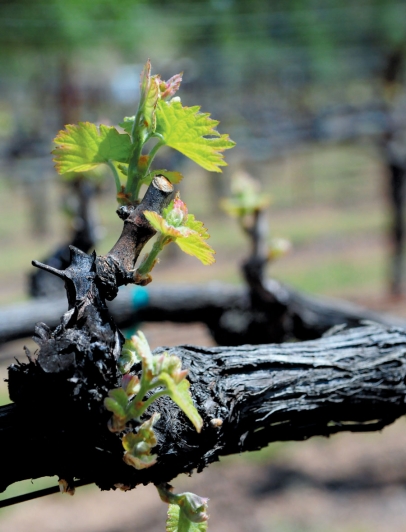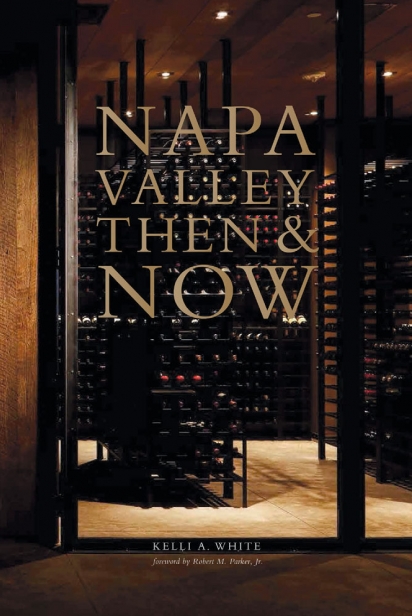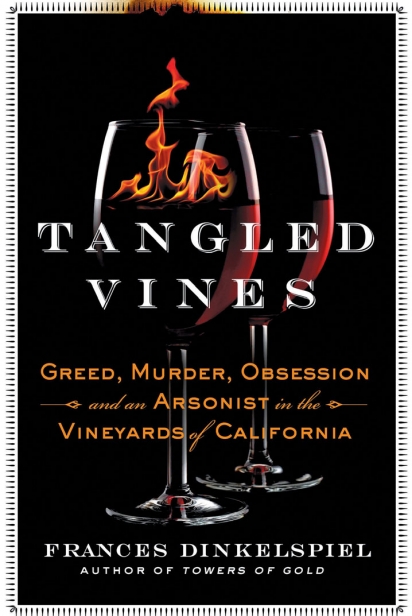Vintage Verbiage
Two new books explore California wine history
Two wildly different but equally compelling books by local authors made their debuts at the end of last year, both of which chronicle the long and storied history of winemaking in California. One reads like a historical novel-cum-crime thriller but is, in fact, a true story. The other is a 1,255-page guide to the wines and wineries of Napa Valley that no less than Robert M. Parker Jr. calls a “flawless, brilliant book,” one that “puts Napa Valley in its proper place as one of the world’s most glamorous, prestigious and rewarding places to grow grapes and produce worldclass, distinctive and individualistic wines.”
Frances Dinkelspiel’s Tangled Vines: Greed, Murder, Obsession, and an Arsonist in the Vineyards of California (St. Martin’s Press, 2015) is a truly fascinating account of the dark yet riveting story of Mark Anderson, the Sausalito man convicted in 2012 of intentionally setting fire to a warehouse in Vallejo that housed millions of dollars worth of California wines in order to cover up his embezzlement of much of the wine entrusted to his wine warehousing enterprise.
The 2005 fire destroyed 4.5 million bottles of wine, with an estimated dollar value of $250 million, but exponentially more in terms of the hearts and souls of the winemakers and vineyard workers whose toil crafted those wines—all destroyed by one propane torch and a canvas bag full of gasoline-soaked rags. Among the wines destroyed were 175 bottles of Port and Angelica made by Dinkelspiel’s great-great-grandfather, the financier Isaias Hellman, in 1875.
A New York Times bestseller in the crime and punishment category, Tangled Vines is not only the story of Anderson’s heinous crimes, it ushers readers into the romantic, yet oftentimes treacherous and deadly, history of winemaking in California.
Napa Valley, Then & Now (Rudd Press, 2015) is the result of four and a half years of extensive field work, and a lot of wine tasting, by Napa resident and sommelier Kelli White.
Named by Food & Wine magazine as one of the top 10 sommeliers in the country in 2013, White and Scott Brenner, her fiancé and co-sommelier at St. Helena’s PRESS restaurant, have, in the words of PRESS owner Leslie Rudd, transformed the wine list at PRESS from a modest collection of Napa’s best wines to something more closely resembling an archive or a library. White’s extensive notes from their travels up and down the valley talking to winemakers and grape growers have been transformed by her, clearly as gifted a writer as a sommelier, into an intelligent yet approachable reference book, complete with very useful tasting notes and gorgeous images. White, an East Coast transplant and self-proclaimed former Old World wine snob, has fallen in love with her subject matter, and it shows.
You might display Napa Valley, Then & Now on your coffee table, but the pages are sure to be well worn.
Edible Marin & Wine Country recently invited White and Dinkelspiel to sit down together over a glass, or two, of fine California wine and have a conversation about their individual paths to the wine country, the processes of writing their respective books, and their shared reverence for the history of California wines and winemaking that inspired their work. Now you, dear readers, can listen in …
—Gibson Thomas
FD: My family first came to California in the 1850s, so in researching and writing my books [Dinkelspiel’s earlier book is Towers of Gold] I’ve had a really fun time using some of my family members as a way to explore California history.
KW: I grew up in Massachusetts before spending a number of years in New York City [as a sommelier at Veritas]. I had been working in the wine industry for some time, but wanted to get closer to wine country, so I moved out to Napa in 2010.
Up until that point, my career had really focused on Old World wines, so there was a lot to learn. I had this idea that the California wine industry began with Robert Mondavi and had always specialized in the creation of rich, powerful Cabernet Sauvignons. As you well know, that couldn’t be further from the truth—the reality is far more complex and exciting—but I am definitely not alone in that misguided notion.
FD: I completely agree with you. Most people don’t know that winemaking in California started in the 18th century and that wine was actually a huge business all the way up to Prohibition. At first, it was largely centered around Southern California, until a disease wiped out most of the grapevines there in the late 1880s.
Interestingly enough, some of the issues that plagued the early California winemakers are still in play today. You have noted that California wines are still often passed over in favor of European wines by consumers on the East Coast. Back in the early days, California winemakers were very much in competition with French and Italian wine brands, and many of the wine drinkers on the East Coast had little to no interest in California wines. So, much of California’s wine history has been spent fighting for recognition.
KW: Exactly. Though today its arguable that some of the world’s most successful brands hail from California, there’s still a lot of resistance abroad and on the East Coast, as well as a lot of unchecked preconceived notions as to what California wine has to offer. I know because I was a part of that world!
FD: Was there a particular American-made wine that surprised and excited you and began to change your perception?
KW: Actually yes, but it was from Washington state, not California. My fiancé and co-sommelier at PRESS Scott Brenner is originally from Seattle, and though he, too, tended to traffic in the Old World, he kept some interesting Washington wines in his cellar. He opened a 1986 Quilceda Creek Cabernet Sauvignon for me, which I swore was top-shelf Bordeaux. It really opened my eyes to the aging potential of American wines.
Your new book is centered on the wine industry—were you a big wine drinker before you starting writing it?
FD: Yes. Though I like wine a lot and I’ve been drinking it for many years, I don’t have deep knowledge of it; I just know what I like. I actually came to the stories in Tangled Vines not from the wine side, but the crime side. Since among the wines destroyed by Mark Anderson in the 2005 Vallejo warehouse fire were 175 bottles of Port and Angelica made by my great-great-grandfather in 1875, I had a personal interest in what happened.
KW: I know you still have a few bottles of the wine made by your great-great-grandfather. This must make you, if not the only, then one of the very few people with any tangible connection to an ancestral winemaker from that era of California’s history. Have you tasted it?
FD: Yes, and it’s actually still good! It cellared so well because it is actually a fortified wine. This also means that it is very rich and you really only want to drink a little bit at a time. When I opened a bottle I was able to share it with a lot of people.
KW: When I was doing the research for Napa Valley, Then & Now, many of the wine history books I read made reference to the oncethriving wine industry in Southern California. I had only a shallow understanding of that history, but your book brought it to life for me in a major way. It’s sad to me that so much of that vineyard land is now completely developed, though it does seem like there’s a resurging interest. Abe Schoener of Scholium Project is working on a new endeavor centered on vineyards around Los Angeles, and, of course, there were those remarkable Moraga wines from Bel Air that Tony Soter made for all those years . . . . Pockets of quality vineyards do still exist.
FD: Southern California, particularly the area around Los Angeles, dominated the wine industry until the late 1880s. LA was even once called “The City of Vines.” Sadly, not much of that is left. The Avila Adobe on Olvera Street near Los Angeles’ historic plaza [now a California State Historic Park], however, has a Mission grapevine still growing that is believed to be 200 years old. It still puts out fruit, which tastes pretty good, and someone is even making wine from it.
KW: That’s an old vine!
FD: Is vine age something you take into consideration when buying wine?
KW: It can be a factor, though it does not guarantee the quality of a wine. Whether or not old vines make for better wines is oft debated. Though I personally believe that, all things being equal, an old vine vineyard will often produce the better wine, I also support old vine wines because I like to know that history is being preserved.
Cabernet Sauvignon did not become the dominant grape of Napa Valley until the early 1990s, so most of the old-vine vineyards left in Napa and the state are planted to other things, most commonly Zinfandel or so-called “mixed black” field blends. Unfortunately, the economic reward for planting Cabernet is so compelling that many historic vineyards succumb to replanting for economic rather than qualitative reasons. These days, it takes a special kind of person to deliberately maintain these old vineyards, and I feel that that stubbornness and individuality should be rewarded. And the historic significance of the resulting wines gives them value beyond the content of the bottle.
FD: Can you talk about how long it took to do the research for Napa Valley, Then & Now—it’s 1,255 pages! Did you visit every winery?
KW: (laughs) From start to finish the book took approximately four and a half years. I started it about six months after I got to Napa.
Yes, I did visit every winery in the book, but I was already committed to traveling around and talking to winemakers for my job as a sommelier curating an all-Napa wine list, so I was effectively killing two birds with one stone. This was important since, as I was also working as a sommelier most of the time I was writing the book, a measure of efficiency was required.
Since the world of Napa wine was so new to me, I was writing down all my observations, impressions and tasting notes anyway, so at some point I decided to turn it into a book.
How long did it take to write Tangled Vines?
FD: Well, there was a long legal case that dragged on, so I started thinking about writing the book in 2009, and finished it in 2014.
KW: But the fire was in 2005? Why the four years before you started writing?
FD: My initial interest was just the fascinating story of Mark Anderson’s trial, which I pitched to the New York Times’ local section. It was really only in researching the trial that I learned that my cousin had put a lot of wine made by our great-great-grandfather in that warehouse, and all those bottles had been destroyed. At that point, I started to think that I could create a book with this dual narrative. Anderson manipulated the legal system such that he wasn’t finally convicted until 2012, which is when I began the writing in earnest.
There are other similar books for other big winemaking regions, like Bordeaux and Burgundy—why do you think there has never before been a book like this on the wines of Napa Valley?
KW: That’s an interesting question. Though I can’t say for sure, I think the reason is that, despite Napa’s celebrated status, it perhaps hasn’t been perceived to require the same level of academic attention as those other regions. But I also think there’s a more general overlooking of American wine history at work. I can’t speak for everyone, but I know that I, as well as many of my colleagues, knew more about the history of Bordeaux, Burgundy and Champagne than the history of our domestic winemaking. In fact, one of the things I liked most about Tangled Vines is the way it made that very history come alive. I learned so much without feeling as though I was reading a history text. It was an engaging narrative that moved through peoples’ lives in a fluid way and also presented the broader context of the times in a way that was very informative.
FD: Good. I’m glad to hear that. I found the history of California wine to be extremely fascinating, especially the early days. A lot of very smart people put their heads together to try and make it work, and they took some wrong turns, including a reliance on Mission grapes and unclean winemaking, but despite those obstacles some truly great wine was made, and it’s fascinating to look back in time and watch that story unfold.
Tangled Vines: Greed, Murder, Obsession, and an Arsonist in the Vineyards of California and Napa Valley, Then & Now are available at local booksellers and online.







